The new style of
Japanese Cuisine spring up in Italy and...
Tea-ceremony dishes are the visual arts like painting, elegant
arts and high arts. The main characteristic of Japanese cuisine
as typified by Tea-ceremony dishes are bring out the uniqueness
of ingredients and materials. In face of ingredients and materials,
chef thinks how to cook it. When they cook the same materials,
they consider a kind, production area and the freshness.
The taste of material is most important to Japanese cuisine
and influence the grade of it. Therefore regarding the Japanese
cuisine, it's not only a cooking technique, but also the expression
of the good taste. This creation is the same a means of realizing
things which a painter and a sculptor drew in a heart with
form and a color. In this creation, chef who inherits ate
tradition gets inspiration from the material and new dishes
is born by trying a new idea. This effort is a great person,
but as far as there is this opportunity, Japanese cuisine
will not erode.
Prologue
After the short movie and music, the main dinner starts… |
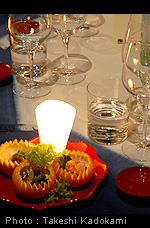 |
Hassun (First Dish)
The first dish consists of small dishes made of citrus
fruit on a flower-shaped vermilion-lacquered dish. These
are: a) Baked shrimp with basil source, b) Crispy Chicken,
and c) Hijiki. Enjoy these with Sake (Japanese wine).
Rikyu created Hassun with a clue from the sacred treasures
of Hachimangu in the south part of Kyoto and it originally
meant a Hassun-sized (approximately 24 x 24 cm) square
tray made by cedar. Later, Hassun became referred to
as appetizers and now it is a name of menu. |
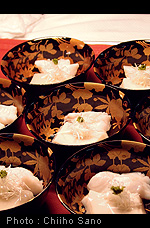 |
Nimonowan (Second Dish)
The used bowl is partly carved and lacquered several
times and various flowers are drawn in gold-relief.
The meals are Tofu made from sesame seeds and baked
white fish from the Mediterranean. I made this typical
Japanese-style soup from dried bonito and dried kelp
(this is called “Dashi”) with salt and soy sauce. The
water we used today is reproducing in association with
Slow Food organization. The kelp for making Dashi is
originally seaweed and it requires a lot of time and
efforts to make it usable. Also, it takes about six
months to make a dried bonito. This becomes a hard piece
through many kinds of process. We slice this dried bonito
and put in the warmed kelp soup to make it more flavorful.
These two elements are the base of the Japanese foods.
We use salt and soy sauce for seasoning. There are many
kinds and ways of use but basically we mix it. The Japanese
foods are prepared by combinations of raw, baked, steamed,
boiled, or fried meals and balancing of the degrees.
I think it is the same thing in the world but the balancing,
timing, and food materials differ according to the country
or area. |
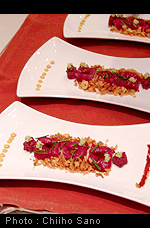 |
Otsukuri (Third Dish)
Otsukuri stands for raw fish. However we can’t get
the good raw fish, then I cook raw meet that is well
known to Piemonte. Since the association instructed
us to provide some wines, I arranged this in the EU
style. Please enjoy it with using a knife and fork.
I put some Karashi (Japanese mustard) on the meet. Eat
it with fried rice and mashed potato. Also, please eat
it with yellow mustard and red pepper for an accent
to make it a little spicy. Sauce is a blend of olive
oil and soy sauce. |
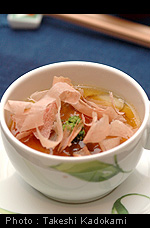 |
Takiawase (Fourth Dish)
This is a char-grilled Porcini in season. Please enjoy
it with a warm and unsweetened pudding. I put some sliced
dried bonito for an accent. The dried bonito are curiously
dancing and look so comical. You will enjoy its tender
taste just like a homemade food. |
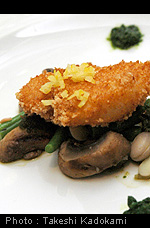 |
Yakimono (Fifth Dish)
This is broiled cod with soy sauce and Mirin (sweet
cooking rice wine). Some funguses and beans are steamed
with salt and it should be tasty with soy source. There
are herbs on the four corners so please enjoy it with
various combinations. |
 |
Gohan (Sixth Dish)
This is a risotto with chestnuts. In Japan, we had
cheese and dairy products already brought over in the
Nara period and we called them “Raku,” “So,” or “Daigo.”
Though they were not so popular at the time, for this
time I just try to reproduce the relic of the Nara period. |
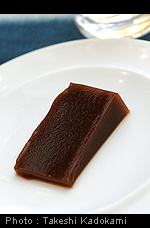 |
Dessert (Seventh Dish)
This is called Mizuyokan (soft jelly) made from azuki
beans. This has a thick taste and a flavor like chocolate.
Please enjoy its affinity with Matcha (Japanese tea). |
|

